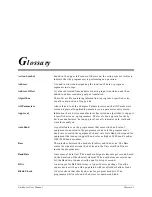
Glossary
Glossary-2
UniSite-xpi User Manual
Block Size
The hexadecimal number of bytes to be transferred in a data transfer. The
beginning of the block is defined by a begin address, and the end of the
block is the sum of the block size and the begin address minus one.
Byte Swap
See Odd/Even Byte Swap.
Cards
Also called PC Cards, these are 68-pin, integrated circuit cards. PC Cards
usually follow the PCMCIA/JEIDA (PC Memory Card International
Association) standards, which govern 68-pin memory or I/O type cards.
Checksum
The sum of all the bytes, expressed in hexadecimal format.
Command Window
The left side of the screen. At the top of the window is the menu name,
displayed in uppercase letters. Below the menu name, the available
commands are displayed in upper- and lowercase characters.
Communications
Parameters
The various settings that determine the I/O characteristics of your
equipment. The parameters include baud rate, stop bits, data bits, and
handshaking.
Compare Electronic ID
A command that compares the electronic signature of the socketed device
with the electronic signature specified in the currently selected algorithm.
Compensated Vector Test
A device test that enables load compensation on PLD output pins under
test during vector testing. This may eliminate structured test errors when
testing PLDs sensitive to output loading, where many of the devices
register transitions simultaneously.
Complex Parameter Screen
See All Parameters.
Computer Remote Control
A command set that may be used to operate a programmer remotely.
These commands are usually the basis for external programmer drivers,
which may operate a programmer from a PC or other host. See also
Remote Mode.
Context-sensitive
Information that changes depending on the cursor position. With the
programmer, every time you move the cursor to a different field, the
information on the online help screen changes.
Continuity Check
A device check that tests for open device pins before performing a device
operation.
CRC
An acronym for Computer Remote Control. See Remote Mode.
Cross Programming
A programming operation that allows a single generic programmable
logic device (PLD) to be configured as any one of many PLD
architectures. Consequently, the generic device can take on the function
of many subset devices. For example, a 16V8 generic PLD can be
configured as a 16R4, 16R8, or 16L8.
Data Bits
A communication parameter that specifies the number of bits per byte.
Data Representation
The manner in which the data in user memory appears on the screen. You
can select either X and -, or 0 and 1, where X and 0 represent an
unprogrammed state, and - and 1 represent a programmed state.
Summary of Contents for UniSite-xpi
Page 2: ...981 0014 UniSite Programming System User Manual Also Covering Legacy UniSite Programmers ...
Page 72: ...2 Setup and Installation 2 42 UniSite xpi User Manual ...
Page 134: ...3 Getting Started 3 62 UniSite xpi User Manual ...
Page 238: ...5 Computer Remote Control 5 10 UniSite xpi User Manual ...
Page 296: ...6 Translation Formats 6 58 UniSite xpi User Manual ...
Page 402: ...Keep Current Subscription Service 6 Keep Current ...













































